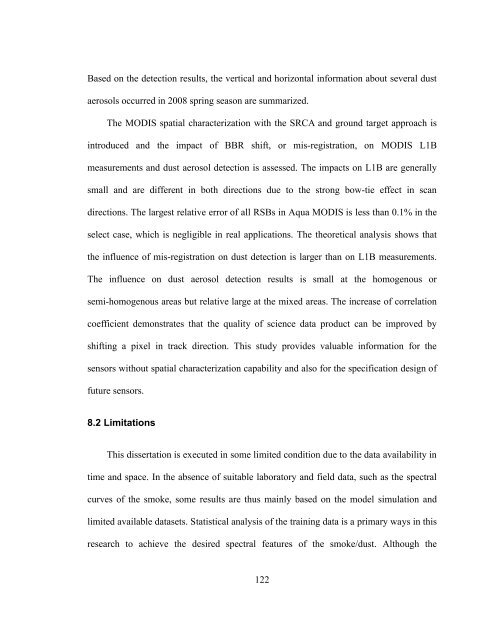i Detection of Smoke and Dust Aerosols Using Multi-sensor Satellite ...
i Detection of Smoke and Dust Aerosols Using Multi-sensor Satellite ...
i Detection of Smoke and Dust Aerosols Using Multi-sensor Satellite ...
You also want an ePaper? Increase the reach of your titles
YUMPU automatically turns print PDFs into web optimized ePapers that Google loves.
Based on the detection results, the vertical <strong>and</strong> horizontal information about several dust<br />
aerosols occurred in 2008 spring season are summarized.<br />
The MODIS spatial characterization with the SRCA <strong>and</strong> ground target approach is<br />
introduced <strong>and</strong> the impact <strong>of</strong> BBR shift, or mis-registration, on MODIS L1B<br />
measurements <strong>and</strong> dust aerosol detection is assessed. The impacts on L1B are generally<br />
small <strong>and</strong> are different in both directions due to the strong bow-tie effect in scan<br />
directions. The largest relative error <strong>of</strong> all RSBs in Aqua MODIS is less than 0.1% in the<br />
select case, which is negligible in real applications. The theoretical analysis shows that<br />
the influence <strong>of</strong> mis-registration on dust detection is larger than on L1B measurements.<br />
The influence on dust aerosol detection results is small at the homogenous or<br />
semi-homogenous areas but relative large at the mixed areas. The increase <strong>of</strong> correlation<br />
coefficient demonstrates that the quality <strong>of</strong> science data product can be improved by<br />
shifting a pixel in track direction. This study provides valuable information for the<br />
<strong>sensor</strong>s without spatial characterization capability <strong>and</strong> also for the specification design <strong>of</strong><br />
future <strong>sensor</strong>s.<br />
8.2 Limitations<br />
This dissertation is executed in some limited condition due to the data availability in<br />
time <strong>and</strong> space. In the absence <strong>of</strong> suitable laboratory <strong>and</strong> field data, such as the spectral<br />
curves <strong>of</strong> the smoke, some results are thus mainly based on the model simulation <strong>and</strong><br />
limited available datasets. Statistical analysis <strong>of</strong> the training data is a primary ways in this<br />
research to achieve the desired spectral features <strong>of</strong> the smoke/dust. Although the<br />
122




![[Sample B: Approval/Signature Sheet] - George Mason University](https://img.yumpu.com/21978828/1/190x245/sample-b-approval-signature-sheet-george-mason-university.jpg?quality=85)


![[Sample B: Approval/Signature Sheet] - George Mason University](https://img.yumpu.com/18694905/1/190x245/sample-b-approval-signature-sheet-george-mason-university.jpg?quality=85)






![[Sample B: Approval/Signature Sheet] - George Mason University](https://img.yumpu.com/18694552/1/189x260/sample-b-approval-signature-sheet-george-mason-university.jpg?quality=85)

![[Sample B: Approval/Signature Sheet] - George Mason University](https://img.yumpu.com/18694474/1/190x245/sample-b-approval-signature-sheet-george-mason-university.jpg?quality=85)